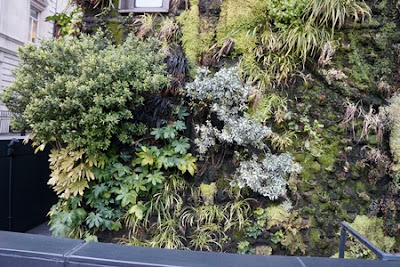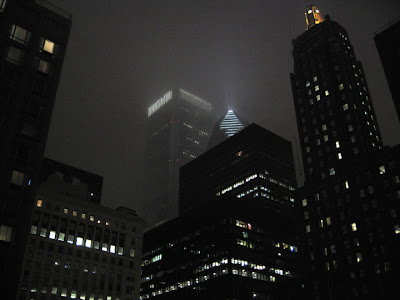 |
| Athenaeum Hotel, London. More than 12,000 plants cover its walls. |
On the front of the Athenaeum Hotel in London, a giant wall of plants climbs to the sky, forming a green tapestry of ferns, moss, flowers and thousands of other plants ten stories high. This vertical garden was created by Frenchman, Patrick Blanc who has turned the idea of gardening on its side. While most people put plants in the ground, Patrick Blanc’s gardens go up in the air. In cities all over the world he has created colorful carpets of plants climbing the walls of homes, shopping centers, hotels, museums, and other buildings, bringing nature’s beauty to crowded cities. Earth Day seems the the perfect day to celebrate Patrick Blanc's vertical gardens,
which are helping to beautify urban spaces around the world.
On a recent trip to London, I got the chance to see two of Patrick Blanc’s amazing gardens, one on the
Athenaeum Hotel and the other on the upper stories of
The Driver, a pub near King’s Cross.
 |
| Patrick Blanc’s vertical gardens are like giant leafy paintings. |
No Dirt!
Patrick Blanc is a botanist at the French National Center for Scientific research. In 1972, when he was a university student, Patrick Blanc took his first trip to Southeast Asia, where he saw ferns growing high in the trees, orchids hanging over waterfalls, and plants clinging to cliffs and other places with no soil. The trees and rocks supported the roots and stems of the plants. Patrick realized then that plants do not need dirt to grow and started to experiment with dirtless gardens at his home in Paris.
For his first vertical gardens, Patrick Blanc used wood for the frame. Now, he uses metal. Then he attaches a layer of PVC plastic to the frame to make the structure rigid and waterproof. Finally, he glues a layer of synthetic felt to the plastic. Water and fertilizer drip onto the felt through holes in pipes at the top of the structure. The plants absorb what they need and, as the roots grow, they penetrate the felt and the plants soon become securely fastened to the structure. Patrick Blanc initially attaches plants to the garden structure with staples, using about thirty plants for every square yard. As the plants begin to grow, the spaces fill in. Then the whole surface becomes a living carpet.
 |
| The Driver, Kings Cross, London |
Living Tapestries
Like a painter, Patrick Blanc chooses the colors and shapes of the plants carefully to make a pleasing design. He must also pick plants that are best for the location of the garden. On tall buildings, plants that need more light are at the top. Shade loving plants go at the bottom. For indoor gardens, he uses tropical plants. For outdoor gardens, he chooses plants that grow in similar climates. In cities such as London or Paris, he chooses plants that come from cooler parts of the world. On the January day we went to see the gardens on The Driver, it had snowed the night before and the north facing wall still had patches of snow on the leaves. But the vines that covered the wall seemed to tolerate the cold and thrive.
Patrick Blanc’s vertical gardens keep buildings cool in summer and warm in winter by providing a layer of natural insulation. The plants also help keep the air fresh by taking in carbon dioxide and giving off oxygen as they grow. In 1996, Patrick Blanc began to work with French architect Jean Nouvel. Together they have designed projects in Seoul, Barcelona, Paris, and elsewhere. Patrick Blanc has created vertical gardens at more than 100 public sites and in many private homes. His largest garden covers an apartment building in Paris on the Rue de Alsace where diagonal bands of leafy plants fill 15,000 square feet of surface space!
 |
| At the Athenaeum Hotel, London |
Some of Patrick Blanc’s garden designs have been created for garden shows and other temporary exhibits. But most are intended to be permanent. They are worth going out of your way to see. If you are in London, take a stroll down Piccadilly Road across from Green Park, and gaze up at the amazing wall of plants that grace the elegant Athenaeum Hotel. You will be amazed!
In French, the vertical garden is called “Le Mur Vegetal”, a name created by Patrick Blanc.
Here are some places around the world where you can see Patrick Blanc’s vertical gardens:
French Embassy, New Delhi, India
Market and Parking Garage, Avignon, France
Parliament, Brussels, Belgium
Apartment Facades, Rue d’Alsace, Paris
Nave Italia Aquarium, Genoa, Italy
Quai Branly Museum, Paris, France
21st Century Museum of Contemporary Art, Kanazawa, Japan
Caixa Forum Museum, Madrid, Spain
Concert Hall, Taipei, Taiwan
Museum of Natural History, Toulouse, France
Girbaud Boutique, New York, New York
Emporium Shopping Center, Bangkok, Thailand
Phyto Universe, New York, New York
Qantas Lounge, Sydney, Australia
Lan Restaurant, Shanghai, China
For beautiful photos and a history of the evolution of Patrick Blanc’s vertical garden concept, read this book:
The Vertical Garden, From Nature to the City by Patrick Blanc (W.W. Norton and Company, NY, 2008. You can also see a photo of Patrick Blanc's vertical garden in Madrid is the July 2012
National Geographic in the Now/City Solutions section at the front of the magazine.
Patrick Blanc’s website:
www.verticalgardenpatrickblanc.com




















